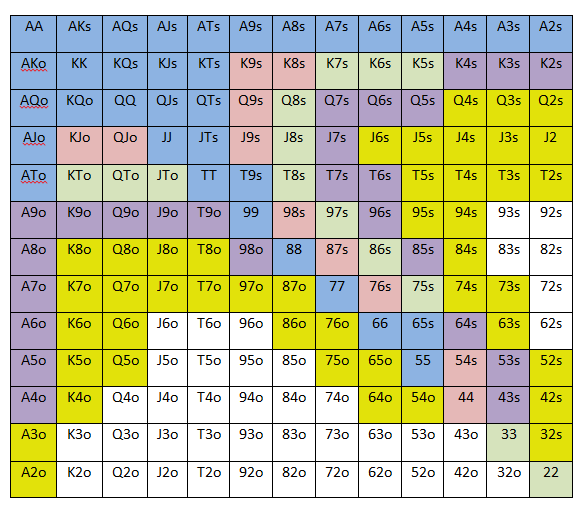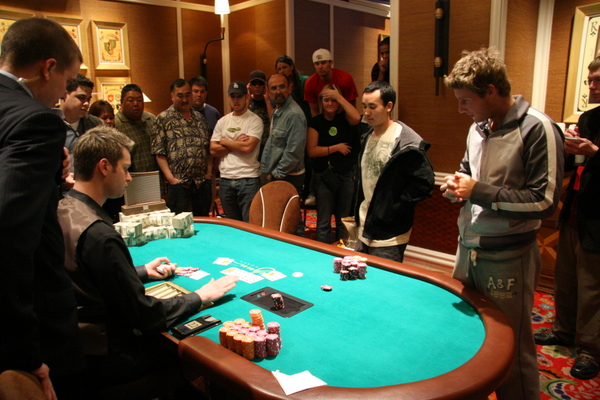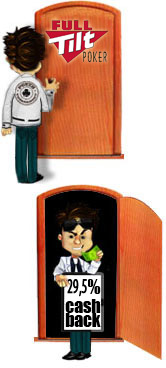Poker Mtt Meaning
Trasition from Cash Games to Tournments
A lot of players that I know of suffer when playing MTTs because they’re more used to a slower cash game environment. In cash games all you have to do is apply to basics, sit out your poor hands and play a tight agressive game in micro-low stakes games. Everything becomes a bit more blurry in tournaments though, with M-zone calculations, more pre-flop shoving action and an overall faster type of game (particularly turbo SNG games at PokerStars).
This means MTT players need way more patience than cash games who can their profitability each hour (BB/hr). Large multi-table tournaments such as the UB Sunday $200k Gtd (950 opponents on average) can require several hours of concentration and consistent performance. This makes the mental and physical side of tournaments much greater. If you've been frustrated with other poker products in the past, feel stuck with your current position in the game, or just want a behind-the-scenes look at the process, approach, and fundamentals that make up a winning MTT strategy, then enroll today to get instant access to your blueprint for winning in today's games. $3.30 NLHE MTT: $3.30 NLHE MTT: $3.30 NL MTT: $3.30 NL MTT: $3.30 NL MTT: $3 NLH Hand Review (ITM) 10 September 1st, 2020 8:49 PM Tournament Hand Analysis $0.25 NLHE MTT: $0,25 NLHE MTT: $0,25. MTT Poker Tournament Strategy - 10 Steps Guide Multi-table tournaments let you play for huge sums of money for a small outlay – aim for a big score on 888poker with our 10-step strategy guide. This means MTT players need way more patience than cash games who can their profitability each hour (BB/hr). Large multi-table tournaments such as the UB Sunday $200k Gtd (950 opponents on average) can require several hours of concentration and consistent performance. This makes the mental and physical side of tournaments much greater.
Tournaments Strategy is More Complicated than Cash Games
In my opinion multi-table tournament strategy is harder to master than cash games, and by master I am referring to a successful loose agressive style of poker which takes advantage of more positional situations and punishing weaker players more often.
Tournament strategy is not about making as many +EV decisions as it is in cash games. In tournaments you have to be more agressive and apply more avanced concepts to your game such as the “M-ratio“, positional steals, hand shoving ranges, the antes, and different opponents each time you’re moved to a table. End game tactics involving ICM concept, “tournament equity” and the the reduction in chip-vale means there’s far more learning involved in tournament play. Cash game players need to stretch their game far more if they want to compete in tournaments. Phil Hellmuth is the world’s greatest poker tournament player and he utilises the a very loose agressive strategy, but when was the last time he dominated the online cash tables or Late Night Poker? Coincidence?
More Loose Agressive Play in Tournaments
Playing tight will work most of the time in low limit cash games, but in tournaments you always need to play agressively and learn to double up fast. To be a successful MTT player you should be overplaying sub-premium hands and taking way bigger risks. You should be value shoving mid-pair in the late stages, 3betting with suited connectors, and regularly attacking and defending the blinds. I also beleive economies of scale of much more evident in tournaments i.e. a big stack has ever-increasing advantages in a tournament as the blinds increase and small stack players tighten up.
Differences in Bet Sizes Between Tournaments and Cash Games
Your bet-sizing should roughly be 25-35% less in tournaments. The bet sizes are relatively smaller in tournaments because players are tighter, fold equity is greater, and the majority of weak/tight players are unwilling to get their hands caught in large pots considerin they only have one chip stack. For more information read bet sizing in tournaments.
Typical Tournament Bet Sizes:
- Pre-flop Raises: 2.25-3x BBs + 1BB for every limper
- Re-raises should be 3x the initial range (for example, opening raise is 300, you re-raise to 900 – this is very standard)
- cbetting should be about 50% – 70% of the pot
Tournaments Require More Patience than Cash Games
You need to think of multi-table tournaments as a journey rather than a single-event. The results and big winnings normally won’t be seen until after maybe 20 or so games (depending on your ability and level). This means MTT players need way more patience than cash games who can their profitability each hour (BB/hr). Large multi-table tournaments such as the UB Sunday $200k Gtd (950 opponents on average) can require several hours of concentration and consistent performance. This makes the mental and physical side of tournaments much greater. You need to be just as sharp at the final table as you were when the event began. Unlike tournments, cash players can give up and walk anytime.

Blind Stealing is More Common in Tournaments
Blinds are worth a hell of alot more in tournaments, especially in the mid-late stages where the antes come in. Because of this you’ll need to not only master blind stealing as a crucial concept, but also blind defending and re-stealing. In regular cash games the blinds are worth about 1% of your chipstack, in regular freezeout MTTs however they can be up to 10% of your total chip stack – particularly at the final table.
Your Chances of a Pay Day Are Much Less in MTTs
Because of the massive number involved in MTTs (5,000 entrants for large MTT events) the chances of making a payoff is much lower than in cash games. Even Chris Moorman, the UK MTT champion has gone up to 20 games online without any return on investment. Tournament bankroll management rules advise you to have a total bankroll of at least 100x buy-ins for your level of multi-tabe tournaments. This is to combat the small probabilities of a successful pay day, the variance inherent in these games, and the minimise putting your bankroll at risk. Grinding MTTs for profit is as much about volume and multi-tabling, as it is for strategy and skill.
One Stack – “One Shot Do Not Miss Your Chance to Blow” (Eminem)
You only have one shot in tournaments, under normal conditions you cannot re-buy or refresh your stack with the click of a button. The risks are massively increased for shoving and overbetting in tournaments and getting into coinflip situations even when you’re a favourite can make you busto. Especially during the run up to the buble you should be playing extremely tight, and never calling a deep stack’s overbet unless you have a massive holding.
Look for the Best MTT Poker Sitesrecommended by our site.

Related articles:
Leave a Reply
- $400
- $2000
T&C apply to bonus offerings
(After you read this post, you might want to check out my follow-up to it here.)
I tell a lot of people not to play large-field online MTTs for a living. I’ve always thought that the variance is just way too high for most professionals to trust their livelihood (and sanity) to large-field MTTs instead of cash, smaller-field MTTs, or STTs. But, admittedly, I’ve given this advice without any direct evidence to back it up. I’ve been meaning for a while to see what the numbers say, and this post will be a tentative first step.
Ideally, what I’d like to do is do a nice controlled study where I pick a few representative players based on past results and use their results over the next few months as my data. (Alternatively, I could take the results of one of the large backing groups. If anyone who backs 20+ people would be down to share some information, let me know.) But, that requires more motivation than I’ve been able to muster, so I decided to do a much rougher study: I grabbed Shaun “SFD” Deeb’s tourney results from OPR (with Shaun’s permission) and played around for a few hours. Here’s what I found:
Mtt Meaning In Poker
I used Shaun’s results from January 2009 to present on Stars and FTP. I filtered for buy-ins between $55 and $216 and included only NLHE tourneys with at least 181 entrants. OPR doesn’t record rebuys, so I removed rebuy tourneys. This left 3,049 tourneys with an average buy-in of $119.72 in which Deeb earned $294,027 with an awesome ROI of 81% and an ITM of 11.5%. Obviously, not many people can play or run as well as Shaun Deeb, but these results provide a starting point.
Say you are Shaun Deeb, you really do have an ROI of 81%, and you’re going to play 1,000 of these tourneys. What are the odds you make money? What are the odds you make at least $50k? Etc etc. Here are the results of one thousand Shaun Deebs each playing one thousand tourneys:
In particular, Shaun loses over a 1,000 tournaments sample about 13% of the time, and he makes less than $50k about 35% of the time (with an EV of about $100k). Of course, the upside is pretty good too–He makes over $200k about 14% of the time and over $300k almost 4% of the time.
Here’s the same data for a larger sample of 3,000 tournaments:
Over 3,000 tourneys, Shaun wins about 98.6% of the time, and he wins over $150k over 82% of the time. He made over $900k once in my 1,000 trials ($915,134) and over $600k about 6% of the time.
Poker Mtt Meaning Games
But, say you’re not Shaun Deeb. I can make a lower ROI player by simply taking Shaun’s distribution and lowering the payouts. (For an ROI of x, multiply the prizes by (1+x)*0.554 .) This isn’t very accurate, but it’s good enough for my purposes (especially since Shaun has a low ITM%). Here’s the 1,000 tourney histogram for a 20% ROI player:
Poker Mtt Meaning Dictionary
As you can see, the situation is way worse. This player loses about 45% of the time and loses over $50,000 about 7% of the time. That’s pretty terrible, but maybe things get better with a larger sample? Here’s the data for 3000 Tourneys:
A 20% ROI player will be a loser over a 3,000 tourney sample almost 26% of the time. That’s much higher than I’d expected, and it’s the sort of number that should scare the shit out of prospective and current MTT professionals–If you want to play MTTs for a living, you better either put in a ton of volume, play really well, or be prepared to be a slave to variance (and nobody’s actually prepared for that).
Here’s lots of data for lots of situations (sorry for the ugly formatting):
| ROI | Tourneys Played | Expected Earn | Chance of Loss | Chance of Earning < .5x EV | Chance of Earning > 1.5x EV | Chance of Earning > 2x EV |
| 20% | 100 | $2,394.53 | 65% | 67% | 30% | 28% |
| 20% | 500 | $11,972.65 | 53% | 60% | 30% | 25% |
| 20% | 1000 | $23,945.30 | 42% | 50% | 36% | 31% |
| 20% | 2000 | $47,890.60 | 33% | 44% | 35% | 25% |
| 20% | 5000 | $119,726.50 | 20% | 38% | 30% | 17% |
| 40% | 100 | $4,789.06 | 61% | 65% | 27% | 23% |
| 40% | 500 | $23,945.30 | 37% | 51% | 31% | 26% |
| 40% | 1000 | $47,890.60 | 29% | 44% | 32% | 23% |
| 40% | 2000 | $95,781.20 | 14% | 33% | 28% | 17% |
| 40% | 5000 | $239,453.00 | 6% | 26% | 21% | 8% |
| 60% | 100 | $7,183.59 | 56% | 63% | 29% | 24% |
| 60% | 500 | $35,917.95 | 29% | 49% | 31% | 25% |
| 60% | 1000 | $71,835.90 | 20% | 41% | 27% | 18% |
| 60% | 2000 | $143,671.80 | 9% | 33% | 26% | 13% |
| 60% | 5000 | $359,179.50 | 1% | 16% | 17% | 4% |
| 80% | 100 | $9,578.12 | 51% | 62% | 25% | 21% |
| 80% | 500 | $47,890.60 | 24% | 46% | 28% | 22% |
| 80% | 1000 | $95,781.20 | 12% | 36% | 28% | 16% |
| 80% | 2000 | $191,562.40 | 5% | 27% | 23% | 9% |
| 80% | 5000 | $478,906.00 | 0% | 13% | 12% | 2% |
| 100% | 100 | $11,972.65 | 47% | 61% | 24% | 18% |
| 100% | 500 | $59,863.25 | 18% | 44% | 25% | 20% |
| 100% | 1000 | $119,726.50 | 9% | 35% | 25% | 11% |
| 100% | 2000 | $239,453.00 | 1% | 24% | 18% | 5% |
| 100% | 5000 | $598,632.50 | 0% | 8% | 10% | 1% |

There’s obviously a lot of information there, but some things jump out. In particular, life totally sucks if you’re a 20% ROI player. Even if you play 5k tourneys (which would be a decent sample for an entire year), you still have a 20% chance of losing money and a 38% chance of making less than ~60k. That totally sucks. Anyone except a true tourney god is more likely to lose over 100 tourneys than to win, which also sucks, and even a great tourney player has a decent chance of losing over 1k+ tournaments or to make only half her expected earn over 5k tournaments. Of course, the upside is good too, but the risk of losing money should be pretty scary to professional MTT players.
I should mention that this data lines up pretty well with my experience. I know a lot of professional MTT players. Losing months are incredibly common for them, and losing years happen fairly often. Years where they way underperform their expectations are typical. So, I hope people consider this before deciding to play (or continue playing) these for a living. People who are really good at MTTs, willing to put in tons of volume, and have huge bankrolls and strong stomachs might be better off playing large field MTTs professionally, but there aren’t many of those people. I think for the vast majority of people, it’s not a good idea (even for those who play very well).
You can find more data and some discussion about the distribution here and here. In future posts (probably coming soon, but I’m not making any promises), I’ll compare this data to cash games (both NLHE and PLO), STTs, and small field MTTs (i.e. 45s and 180s). I’ll also look into how stuff like this affects backing. So, if that stuff interests you, stay tuned or whatever. You can follow me on twitter if you want to know when my posts go up, or just subscribe to my RSS feed.